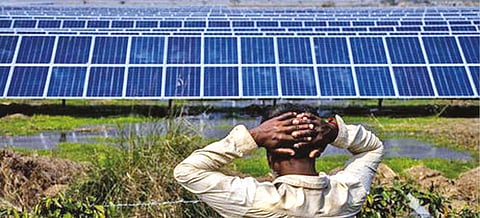

CHENNAI: Russia’s war on Ukraine has triggered a huge rise in global crude oil prices and for India, which imports 80% of its crude oil and 45% of its natural gas, there is a high price to pay. The war is driving up food inflation and increasing manufacturing production prices. India’s wholesale price-based inflation quickened to 14.55 % in March from 13.11 % in February amid hardening of fuel prices. Retail inflation last month has also climbed to 6.95 %, a 17-month high, as food prices went up. Given that fossil fuels are intrinsically economically volatile, experts believe that one viable way to shield consumers from global oil price fluctuations, in the long term, is to cut reliance on fossil fuels by boosting India’s clean energy capacities.
Currently, India’s energy mix is skewed towards the use of coal for power generation, oil for transport and industry, and biomass for residential heating and cooking. Since the 1990s, over 80% of India’s energy needs have been largely met by the three — Coal, Oil and Biomass (COB). Increasing electricity output while cutting coal will require huge growth in renewables, especially wind and solar, paired with energy storage. High energy prices could also make it harder politically for some countries to push through green policies.
According to Chandra Bhushan, CEO of the International Forum for Environment, Sustainability and Technology, the conflict in Ukraine has clearly brought out the vulnerabilities in India’s energy security framework. “The ever-increasing import of fossil fuels, the increasing energy prices coupled with increasing impacts of the climate crisis means that India will have to quickly shift its energy sources that are renewable, less inflationary and can be sourced domestically,” Bhushan told DW. “While the progress on renewables is quite impressive so far, to meet the Glasgow targets India will have to increase installation of solar energy by at least thrice the rate than in the past. It will also need to invest massively in storage and grid infrastructure. These will be difficult but necessary adjustments that India should make for energy security and climate crisis,” he added.
The share of renewables in global energy production has grown steadily over the last few decades. The government has set targets to reduce India’s total projected carbon emission by 1 billion tons by 2030, reduce the carbon intensity of the nation’s economy by less than 45% by the end of the decade, achieve net-zero carbon emissions by 2070, and expand India’s renewable energy installed capacity to 500 gigawatts (GW) by 2030.
Onshore wind and solar are India’s principal renewable energy contributors and are on the right track to reach the target of 175 GW for the financial year 2022-23. Moreover, a goal for India to become a global hub for electric vehicles and green hydrogen production has been unveiled.
“Global events have revealed that reliance on imported fuels can be expensive, risk energy security and can dampen economic growth. India should fuel its economic growth by substituting coal, oil and gas demand with renewable energy alternatives,” Vibhuti Garg, lead energy economist at the Institute for Energy Economics and Financial Analysis, told DW.
Garg pointed out that even though India is decarbonising its electricity sector, more impetus should be given to the decarbonisation of transport and other hard-to-abate sectors like steel and fertilisers, through prioritising new technologies like green hydrogen.
“The Indian government has a target to increase the share of gas in India’s energy mix from 6% in 2021 to 15% by 2030. But to meet its energy demand, rather relying on gas as a transitory fuel, India can build renewable energy capacity,” she said.
In order for the country’s 50% energy requirement to be met using renewables from the current levels of 3%, a 1,567% of growth rate is required over the next nine years, according to a study released by the Council on Energy, Environment and Water (CEEW). The study said India would have to increase its solar power capacity to 5630 GW from its current 41 GW in order to become a net-zero emissions nation by 2070.
Green hydrogen could contribute 19% of the energy consumed by industry in 2070 and transition to net-zero could cost India 4.1% of GDP in that time frame. Observers maintained that the direct impact of oil price shocks is that there is an inflationary consequence on the economy along with an increase in the import bill, thus posing a challenge for macroeconomic management.
“India is minimising this impact through buying subsidised oil directly from Russia. The impact on other energy sectors like solar depends on the extent of the hit such global price shocks and macroeconomic headwinds have on domestic fiscal resources,” Vaibhav Chaturvedi, a fellow at CEEW, told DW.
Chaturvedi pointed out that if fiscal resources are hit hard, less funds would be available, in terms of policy, to support many sectors, and this could impact the pace of solar additions.
“If the landed cost of imported panels increases due to higher transportation cost and other global macroeconomic dynamics, it again wouldn’t bode well for India’s solar ambition. So, while ascertaining the exact impact on solar targets is very difficult, one could say that the Russia-Ukraine crisis will definitely make it more challenging for Indian policy makers,” he added.
India is on the right path to energy transition with building blocks for a low-emissions future being put in place, but “developers and investors now need to be confident in stable and robust policies that do not change with political upheaval,” said Garg.
This article was provided by Deutsche Welle
Visit news.dtnext.in to explore our interactive epaper!
Download the DT Next app for more exciting features!
Click here for iOS
Click here for Android